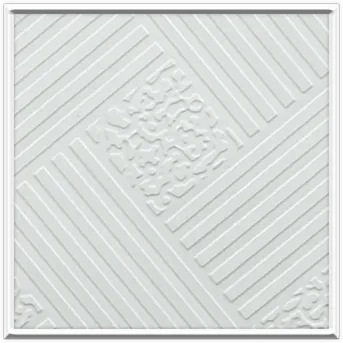Dec . 05, 2024 21:48 Back to list
Ceiling T-Bar Framework for Suspended Ceiling Installation and Support Solutions
The Ceiling T-Bar System An Overview
The ceiling T-bar system, also known as a suspended ceiling or drop ceiling, is a widely used architectural feature in both commercial and residential buildings. This system not only offers functional benefits but also enhances aesthetic appeal in a space. In this article, we will explore the components, advantages, installation process, and common applications of ceiling T-bar systems.
Components of the T-Bar System
The T-bar system consists primarily of metal T-shaped runners, which serve as the framework for the ceiling tiles. The two main components include
1. Main Runners These are long, horizontal bars that run the length of the room. They are typically spaced 4 feet apart and provide primary support for the ceiling tiles.
2. Cross Tees These are shorter bars that connect to the main runners. They create a grid pattern and help to support individual ceiling tiles. The spacing of cross tees generally follows the dimensions of ceiling tiles, usually 2 feet by 2 feet or 2 feet by 4 feet.
3. Ceiling Tiles These come in various materials such as mineral fiber, metal, and plastic, and serve not only to cover the T-bar framework but also to improve the acoustics and aesthetics of the room.
4. Hangers and Clips These are used to suspend the T-bar framework from the overhead structure, ensuring stability and proper alignment.
Advantages of the Ceiling T-Bar System
The ceiling T-bar system offers numerous advantages that make it a popular choice for many building projects
- Ease of Installation The modular nature of the T-bar system allows for quick and easy installation. Even those with minimal construction experience can typically handle the installation, making it cost-effective.
- Accessibility One of the main benefits of a drop ceiling is the easy access it provides to plumbing, electrical wiring, and HVAC systems. This accessibility is crucial for maintenance and repairs.
- Aesthetic Flexibility T-bar ceilings are available in various designs, textures, and colors, which can complement or enhance the overall decor of a space. This aesthetic flexibility allows for creative expression in both commercial and residential buildings.
- Acoustic Control Ceiling tiles in a T-bar system can significantly improve sound quality within a space. Acoustic tiles are designed to absorb sound, reducing noise levels in busy environments such as offices or schools.
ceiling t bar system

- Energy Efficiency Many ceiling tiles have insulation properties that can help in regulating indoor temperatures. This energy efficiency can lead to significant cost savings on heating and cooling bills.
Installation Process
The installation of a ceiling T-bar system involves several steps
1. Planning Measure the dimensions of the room and plan the placement of the T-bar grid system. Mark the desired height of the ceiling and ensure it meets building codes.
2. Installing Hangers Secure the hangers to the ceiling joists or beams at regular intervals. This setup will support the main runners.
3. Placing Main Runners and Cross Tees Start by installing the main runners at the marked locations. Once they are secure, place the cross tees perpendicular to the main runners, forming a grid.
4. Inserting Ceiling Tiles Finally, press the ceiling tiles into place within the grid, making sure they fit snugly.
Common Applications
The T-bar ceiling system is commonly used in various settings, including
- Commercial Spaces Offices, schools, retail stores, and hospitals benefit significantly from the modular design and acoustic properties of T-bar ceilings.
- Residential Areas Many homeowners opt for T-bar ceilings in basements and recreational rooms, where functional and aesthetic considerations are crucial.
- Industrial Facilities In warehouses and manufacturing plants, T-bar systems can offer organizational benefits while maintaining necessary safety standards.
Conclusion
The ceiling T-bar system is a practical solution for many building needs, combining function and aesthetics effectively. Its ease of installation, accessibility for maintenance, and ability to enhance acoustics make it an ideal choice for a wide variety of applications. Whether in a commercial office or a cozy residential space, T-bar ceilings continue to be a favored option, demonstrating their reliability and versatility in modern architecture.
-
Quality Ceiling Trap Doors & Access Panels | Easy & Secure AccessNewsAug.30,2025
-
Durable Ceiling T Grid Systems | Easy InstallationNewsAug.29,2025
-
PVC Gypsum Ceiling: Durable, Laminated Tiles for Modern SpacesNewsAug.28,2025
-
Pvc Gypsum Ceiling Is DurableNewsAug.21,2025
-
Mineral Fiber Board Is DurableNewsAug.21,2025
-
Ceiling Tile Clip Reusable DesignNewsAug.21,2025







